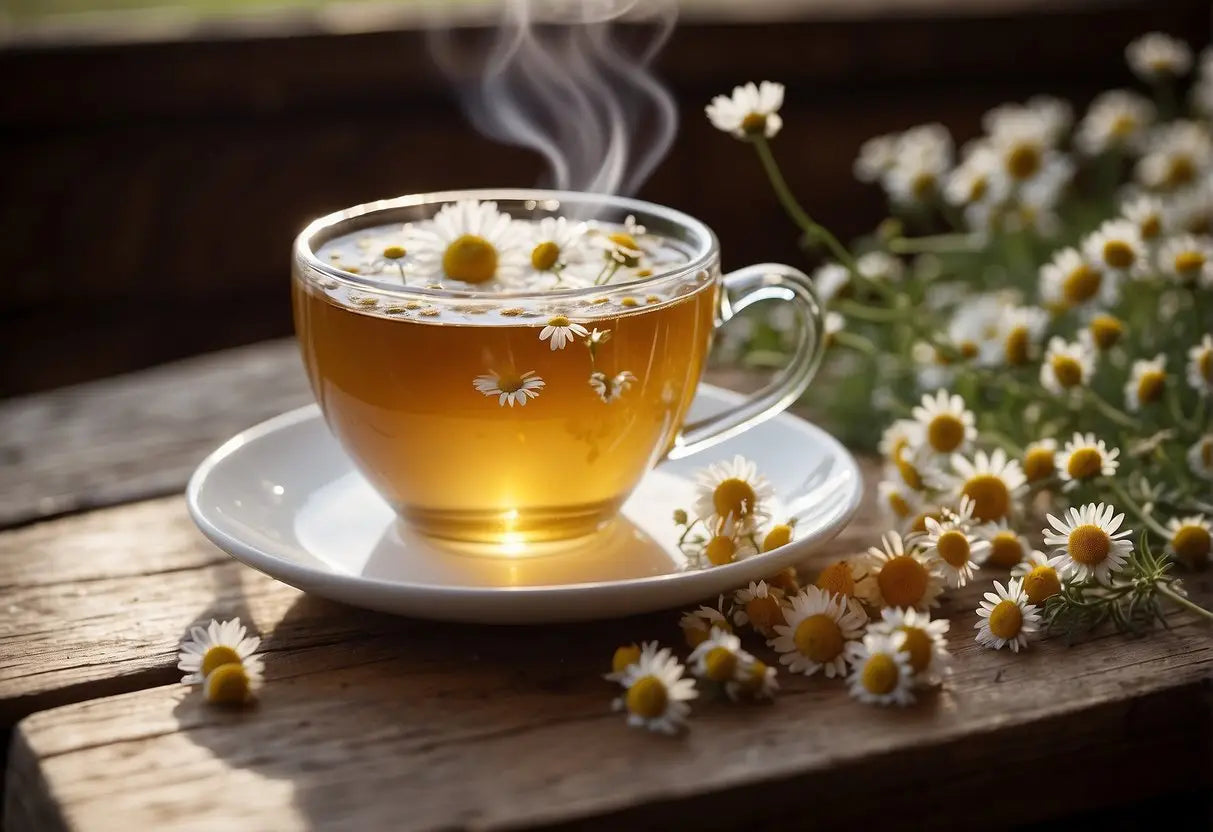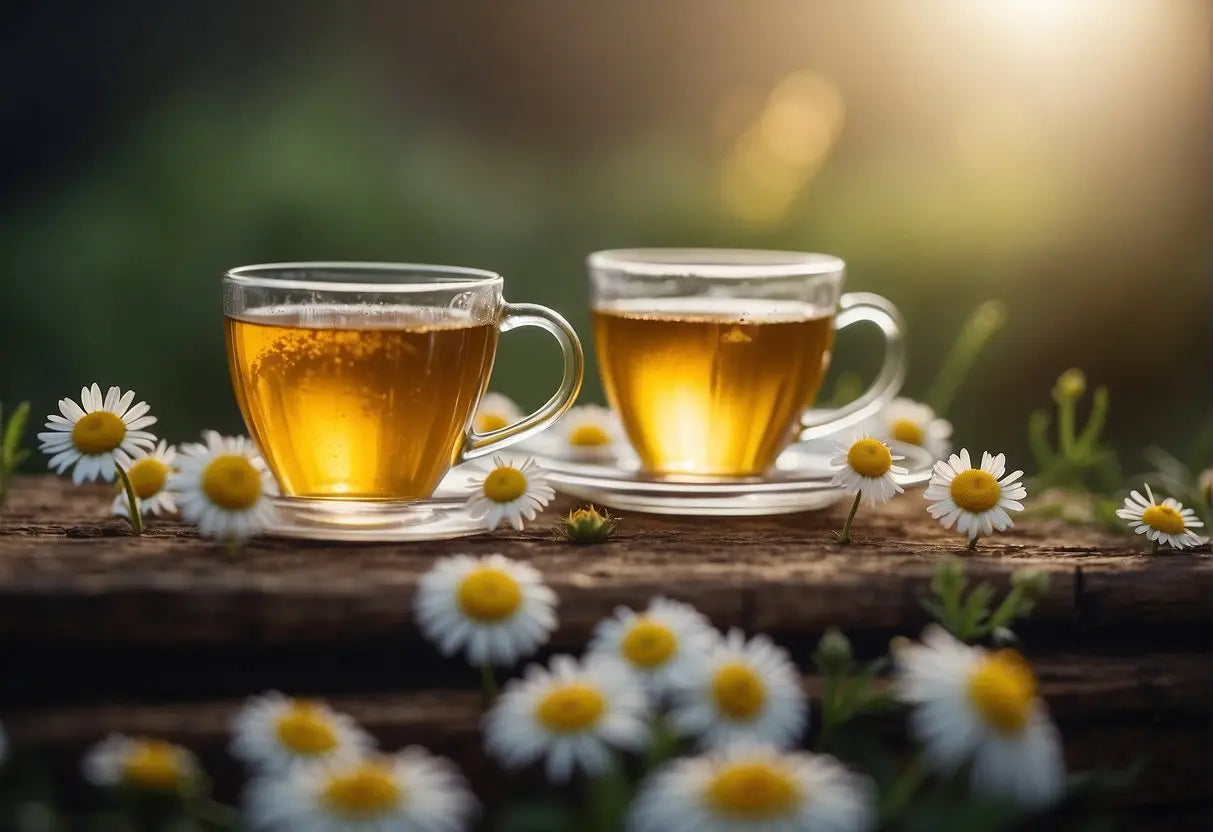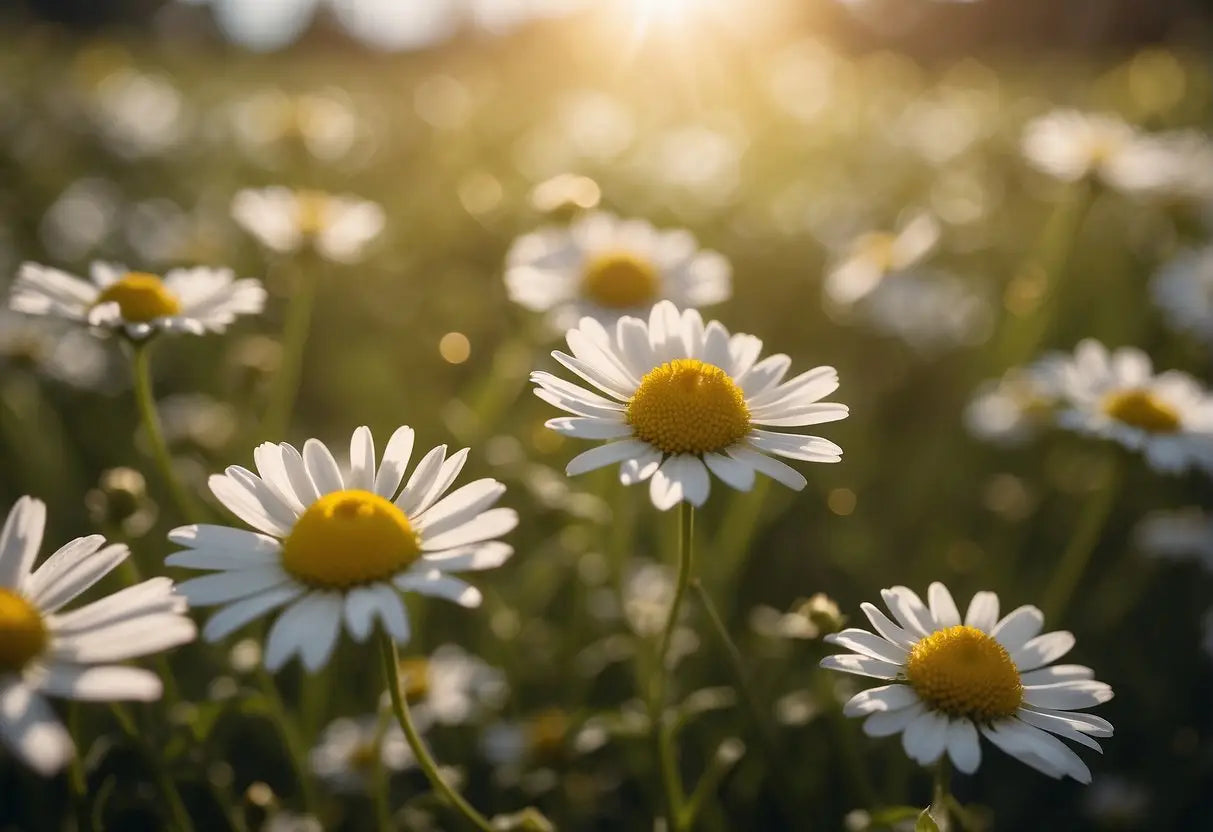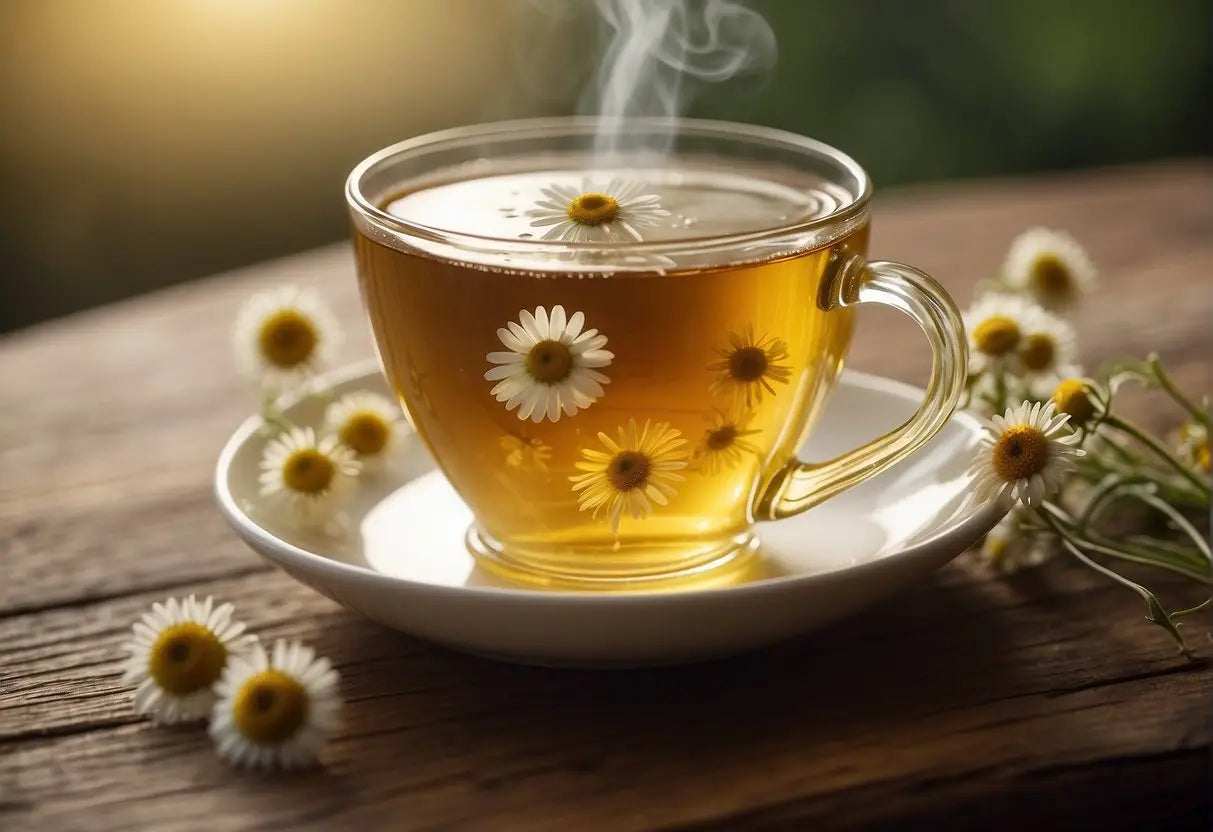What Does Chamomile Tea Taste Like
Shop our Pu Erh Tea collections!
When you sip chamomile tea, you'll likely first notice its soft, somewhat sweet taste. It's subtle, not overwhelming, and has a gentle floral character, reminiscent of apple blossoms. The flavor unfolds gradually, revealing notes of apple and a slight earthiness.
- Primary Tastes: Sweet, Floral
- Secondary Notes: Apple, Earthy
The texture of the tea can be described as smooth, lacking any astringency that is commonly found in other teas such as green or black varieties. This is why many people find chamomile tea comforting, especially before bedtime.
Bestsellers
Organoleptic Qualities:
- Aroma: Delicate, Fresh, Slightly Sweet
- Mouthfeel: Smooth, Light, No bitterness
Chamomile tea can vary in intensity depending on how long it's steeped; a longer steeping time will coax out more depth from the flowers. However, over-steeping might lead to a bitter taste, so it's important to find a balance to ensure the intrinsic mild sweetness remains present.
- Preparation Tip: Steep for 4-5 minutes for an optimal flavor balance.
You might also detect a touch of honeysuckle or vanilla as secondary notes, depending on the chamomile blend and where the flowers are sourced. These nuances contribute to the overall soothing experience of drinking chamomile tea.
Brewing Considerations:
- Steeping Time: Directly affects intensity
- Water Temperature: Preferably around 98°C (208°F)
- Additives: Honey or lemon can complement the natural flavors
Discover our best-selling raw Pu Erh tea and elevate your tea experience today!
Brewing Techniques and Their Impact on Taste

When brewing chamomile tea, the taste can vary significantly depending on the technique used. To achieve the best flavor, consider these factors:
Water Temperature:
- Hot Water: Pouring boiling water over chamomile flowers results in a strong, more bitter brew.
- Warm Water: Using water around 160-180°F can produce a smoother taste.
Steeping Time:
- Short Steeping (3-5 minutes): Yields a milder, sweeter tea.
- Long Steeping (5-10 minutes): Intensifies the flavors, potentially making the tea more bitter.
Tea Quantity:
- More Flowers: For a more robust flavor, add more chamomile flowers.
- Fewer Flowers: Use fewer flowers for a lighter, more delicate taste.
Covering While Steeping:
- Covered: Keeping the vessel covered while steeping helps to trap essential oils, enhancing the flavor.
- Uncovered: An uncovered brew may lead to a more muted taste as aromatic compounds escape.
Pre-rinse:
Lao Ban Zhang
- A pre-rinse of the chamomile flowers with cold water can remove any impurities and result in a cleaner taste.
| Factor | Result |
|---|---|
| Hotter Water | Stronger, more bitter |
| Warmer Water | Smoother, milder |
| Short Steep | Sweeter, less intense |
| Long Steep | Bolder, more bitter |
| More Flowers | Robust flavor |
| Fewer Flowers | Delicate taste |
| Covered Steep | Enhanced aroma |
| Uncovered Steep | Muted taste |
| Pre-rinse | Cleaner taste |
Perfecting your brewing technique requires experimentation to suit your personal taste preferences. Pay attention to these parameters to control the taste of your chamomile tea.
Common Flavor Comparisons

When you sip chamomile tea, expect a mild and soothing taste often likened to a crisp apple. The flavor profile is subtly sweet with floral notes, providing a calming experience. Here's how chamomile tea's taste compares to other common beverages:
- Apple Juice: Chamomile tea has a lighter, less sugary taste compared to apple juice but shares a similar fresh, fruity undertone.
- Green Tea: While green tea can have a grassy and sometimes astringent flavor, chamomile tea is smoother and lacks bitterness, offering a more mellow cup.
To elaborate on texture and aftertaste aspects:
| Aspect | Chamomile Tea | Common Comparisons |
|---|---|---|
| Texture | Light and comforting | Green tea: often brisker |
| Aftertaste | Clean, with a slight floral hint | Herbal teas: can vary greatly, sometimes more intense |
Your tea can also vary in flavor depending on the preparation:
- Strength: A longer steep time will result in a more potent floral flavor.
- Additives: The addition of honey or lemon can enhance the natural sweetness or add a citrusy kick, respectively, altering the primary taste profile.
In essence, chamomile tea provides a unique taste experience that is both familiar and distinguished from other teas and beverages. Its gentle nature makes it a popular choice for relaxation and enjoyment by tea enthusiasts.
Varieties of Chamomile and Their Tastes

Chamomile is a well-loved herb known for its soothing properties and its tea, with two primary varieties offering subtle differences in flavor:
-
German Chamomile: This variety, known botanically as Matricaria recutita, typically has a mild, slightly sweet taste with hints of apple. Many describe the subtle fruitiness of German chamomile tea as calming and refreshing.
-
Roman Chamomile: Referred to scientifically as Chamaemelum nobile, Roman chamomile often presents a more intense flavor. It leans toward a slightly bitter and earthy taste in comparison to its German counterpart. Some individuals detect floral notes and a hint of sweetness akin to honey.
When brewing chamomile tea, the strength of flavor depends largely on the brewing time:
- Shorter brewing (up to 5 minutes): Yields a milder, gentler flavor.
- Longer brewing (over 5 minutes): Results in a more potent taste.
Your chamomile tea experience can also vary based on additional factors:
- Freshness of flowers: Fresher chamomile tends to offer a more pronounced taste.
- Whole flowers vs. tea bags: Loose, whole chamomile flowers usually deliver a richer and fuller flavor compared to pre-packaged tea bags.
- Additives: Adding honey or lemon not only modifies the sweetness or tartness but can also enhance the inherent flavors in different chamomile varieties.
Whether you prefer the gentle sweetness of German chamomile or the more robust notes of Roman chamomile, sample both to appreciate the distinct sensory profiles each provides.
Influence of Harvesting Time on Flavor

When you select chamomile for brewing tea, the time of year it was harvested plays a critical role in determining the subtleties of its flavor profile.
Early Harvest:
- Flavor: More delicate and slightly sweeter
- Aroma: Light and floral
Peak Harvest:
- Flavor: Full-bodied with a hint of apple-like sweetness
- Aroma: Strong, fragrant with more pronounced floral notes
Late Harvest:
- Flavor: Slightly bitter with a more earthy tone
- Aroma: Less floral, heavier earthy scents
The stage of bloom at harvest also affects taste. Ideally, you should look for chamomile that's harvested when the flowers are fully open, as this is when the essential oils, which are responsible for flavor and aroma, are most potent.
| Harvest Timing | Flavor Note | Aroma Note |
|---|---|---|
| Early | Delicate, sweet | Light, floral |
| Peak | Full-bodied, sweet | Strong, floral |
| Late | Earthy, slightly bitter | Earthy, less floral |
Chamomile's taste is also influenced by the drying process post-harvest. Slow, natural drying preserves its delicate nuances, whereas rapid or artificial drying methods can result in a duller flavor profile. Opt for chamomile that has been processed with care to ensure the best taste experience. Remember, the purity of flavor in your tea hinges not only on the quality of the flowers but also on these vital harvesting and processing decisions.
Effects of Additives on Chamomile Tea Taste

When you introduce additives into your chamomile tea, the flavor profile changes significantly. Honey is a common sweetener that brings a rich, natural sweetness to the tea, sometimes adding notes of floral or fruity depending on the type. Here's how different additives can alter the taste:
- Honey: Enhances sweetness with a floral touch.
- Lemon: Adds a tangy, refreshing zest.
- Mint: Introduces a cool, sharp note.
- Cinnamon: Provides a warm, spicy undertone.
Sweeteners
Adding a sweetener can counteract any bitterness in chamomile tea. While sugar is the most traditional choice, its neutral sweetness doesn't contribute any additional flavors.
- Sugar: Offers a plain sweetness.
- Agave syrup: An alternative with a slight caramel-like taste.
Dairy and Non-Dairy Alternatives
Creaminess is added either through milk or plant-based alternatives, which can soften the typically light chamomile flavor.
- Milk: Adds a creamy texture and neutral taste.
- Almond milk: Offers a nutty flavor with added richness.
Spices
Spices can completely transform chamomile tea, bringing complexity and depth.
- Ginger: Contributes a warm, spicy kick.
- Vanilla extract: Infuses a comforting, sweet aroma and taste.
By understanding these additive effects, you can tailor your chamomile tea to your preferred taste profile. Keep in mind that the quality and quantity of these additives will impact the final taste of your tea. Experimenting with different amounts and combinations will help you discover your perfect cup of chamomile tea.
Taste Variations by Region

When you sip chamomile tea, you're experiencing a flavor shaped by the region where the chamomile was grown. Each area imparts subtle differences that influence the tea's taste profile.
Egypt: Egyptian chamomile often presents a strong, pungent taste. Its tea has a deep yellow hue and a robust, floral essence that can have a slightly earthy note.
Europe:
- Germany: German chamomile tea tends to have a milder flavor, with a soothing, slightly sweet quality and hints of apple.
- Romania: Romanian varieties might strike you with a more intense aroma and a sharper taste, which can sometimes include a bitter note.
South America:
- Argentina: Here, chamomile might surprise you with fruitier nuances, coupled with a more mellow and less bitter taste.
- Chile: In contrast, Chilean chamomile may lean towards a slightly more astringent flavor compared to its counterparts.
| Region | Flavor Characteristics |
|---|---|
| Egypt | Strong, pungent, earthy |
| Germany | Mild, sweet with hints of apple |
| Romania | Intense aroma, sharp, sometimes bitter |
| Argentina | Fruity nuances, mellow |
| Chile | Astringent |
The soil composition, the climate conditions, and the harvesting methods in each region influence the essential oils in the chamomile flowers. These factors are responsible for the distinct flavors you experience. Remember, the preparation method can also affect the final taste of your chamomile tea, but the regional variances form the foundation of each cup's unique character.
Frequently Asked Questions
Explore the detailed nuances and frequently highlighted points regarding chamomile tea, including its flavor profile, health benefits, and potential effects on sleep and relaxation.
What are the potential health benefits of drinking chamomile tea?
Chamomile tea is renowned for its calming properties and is often used to reduce stress. It also contains antioxidants that may support heart health and help in controlling blood sugar levels.
Is there any caffeine content in chamomile tea?
Chamomile tea is naturally caffeine-free. This makes it a suitable choice for individuals seeking to limit their caffeine intake.
How would you describe the flavor profile of chamomile tea?
The flavor of chamomile tea is typically described as mildly sweet with subtle floral notes. It can also carry a hint of apple-like taste and a soft, earthy quality.
Can drinking chamomile tea help with sleep?
Many people consume chamomile tea before bedtime as it is believed to have mild sedative effects that might facilitate better sleep.
Are there any known side effects associated with consuming chamomile tea?
Chamomile tea is generally considered safe for most people. However, in rare cases, it may cause allergic reactions, particularly in individuals sensitive to plants in the daisy family.
How does the aroma of chamomile tea compare to its taste?
The aroma of chamomile tea is often floral and herbaceous, closely mirroring its delicate flavor. This scent can enhance the overall soothing experience of drinking the tea.
← Older post Newer post →











